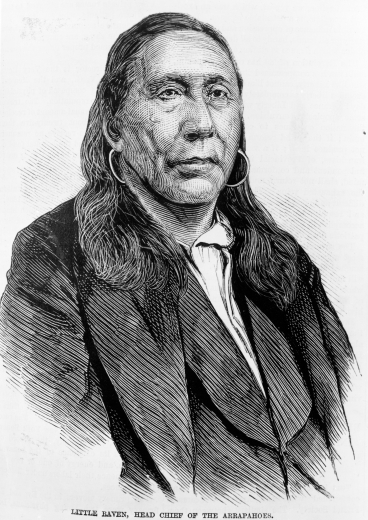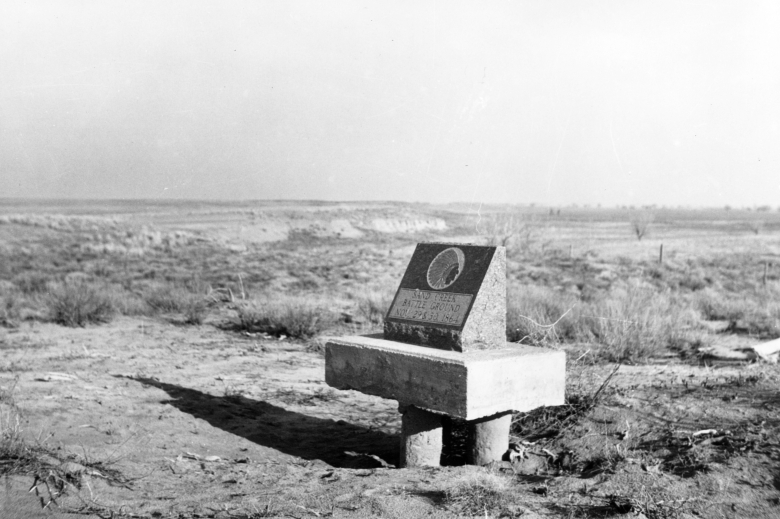Born around 1810 on the Great Plains, Little Raven was Hinono'ei (Arapaho) and a principal Southern Arapaho chief who was known for his commitment to maintaining peace.
Little Raven had a traditional childhood in Cheyenne and Arapaho territory that stretched between the North Platte and Arkansas rivers, from central Kansas to the front range of the Rocky Mountains. He grew up playing games and learning how to identify edible plants, hunt, and ride horses while being raised by an extended family of uncles, aunts, cousins, and grandparents. He signed many treaties with the United States Government in the hopes that working with the federal government would lead to peace between his tribe and white settlers. An early example of Little Raven brokering peace was when he mediated peace between Southern Arapaho, the Cheyenne, and the Kiowa with the Comanche and Plains Apache in 1840. He was present at the signing of the Treaty of Fort Laramie in 1851. The federal government amended and changed the terms of the treaty after it was signed, and further violated the terms of the treaty by establishing the Colorado Territory in 1860.
In 1861, he signed the Treaty of Fort Wise, a treaty that pushed Arapaho onto reservations in exchange for financial support and access to hunting grounds on the plains. This treaty was again violated by the federal government and white settlers. In 1864, hostile relations between the Indigenous people of Colorado and white settlers would culminate in the Sand Creek Massacre. In August 1864, Colorado Governor John Evans issued a proclamation that “all hostile Indians would be pursued and destroyed” and authorized the arming of militias to “pursue and destroy” any Indigenous people who did not move their camps near a military fort in exchange for the promise of safety and protection.
At Big Sandy Creek, 40 miles north of Fort Lyon, Chiefs Black Kettle, White Antelope, Left Hand, and others had set up camp with around 750 people from the Arapaho and Cheyenne tribes. They had camped there believing they were under the protection of the U.S. Army on their ratified treaty lands. Despite this, on November 29, 1864, Colonel John M. Chivington led 675 U.S. volunteer soldiers to the village of Cheyenne and Arapaho at Big Sandy Creek and attacked and killed 230 people, most of whom were women, children, and elders. Little Raven and his band of Arapaho were present at the Sand Creek Massacre and survived because they were camped farther away from the other Cheyenne and Arapaho bands that were attacked and murdered by Colonel Chivington and his troops. Today, the National Park Service maintains the Sand Creek Massacre National Historic Site and people can visit the site and learn more.
Despite the breaking of past treaties and the Sand Creek Massacre, Little Raven remained committed to peace and signed the Medicine Lodge Treaty in 1867, an agreement that moved the Southern Arapaho to a reservation between the Arkansas and Cimarron rivers in Indian Territory (present day Oklahoma). After the Battle of Washita in November of 1868, in which Lt. Col. George Armstrong Custer raided Black Kettle’s winter camp, killing Black Kettle and many others, Little Raven moved his band to Fort Sill for protection. Eventually they and the Southern Cheyenne were granted a reservation in western Indian Territory.
During the 1870s, Little Raven toured Washington, D.C. and other Eastern cities, speaking to large audiences. He was offered, and he refused, a peace medal from President Grant on the grounds that he had no peace talk to make because he had never been at war with white settlers. His influence during the Red River War of 1874-1875 kept the Southern Arapaho neutral during the conflict. Eventually he settled at Cantonment, which is in present-day Blaine County, Oklahoma. He lived here until his death in 1889. Little Raven Street, which runs along Commons Park and the South Platte River, between 15th St. and 20th St. in Denver, CO, commemorates the Arapaho chief. The City of Arvada has also named a park after the chief that was commemorated in the summer of 2023.
Indigenous - people who originally lived in and may continue to live in an area
Ratified - accepted and made official
Band - a smaller group of people who also belong to a larger tribe
Why would Little Raven claim he had never been at war with settlers and refuse a peace medal from President Grant?
In what ways did Little Raven’s leadership help his people?
Has there been a time in your life when you decided to make peace with someone who mistreated you?



